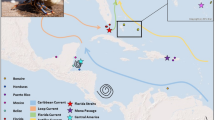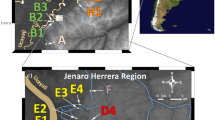Abstract
Alcolapia is a minor genus of small-bodied, polymorphic cichlids inhabiting the lagoons and hot springs surrounding the soda lakes Natron (largely in Tanzania) and Magadi (Kenya). Three Alcolapia species are present at Natron (Alcolapia alcalicus, Alcolapia ndalalani and Alcolapia latilabris) and one at Magadi (Alcolapia grahami). All are IUCN Red Listed as either vulnerable or endangered. We performed analyses of morphometric and genetic structure on 13 populations of the Natron Alcolapia flock, and one A. grahami population of Lake Magadi as an out-group. Morphometric analyses revealed significant differentiation in the head and mouth shape of the species at Natron. From a genetic perspective, among 70 mtDNA control region sequences 17 haplotypes were found, showing in the minimum spanning network a star-like pattern around the widespread haplotype 2lat. At Natron, there was limited genetic differentiation between the different populations of A. alcalicus and A. latilabris, despite apparent ecological barriers of extreme alkalinity that suggested their populations were isolated. Instead, there appeared to be some population connectivity, with a rate of 0.5–2.3 migrants per generation suggesting that natural factors, such as intense rains or transmission by large piscivorous birds, facilitate population connectivity and maintain genetic similarity. The outputs of high population connectivity and one genetic unit at the basin level (despite morphological divergence) suggest that any human activities that disrupt the connectivity of the freshwater resources of the Natron catchment could further threaten the integrity and current status of these already threatened fish populations.





Similar content being viewed by others
References
Abila R, Salzburger W, Ndonga MF, Owiti DO, Barluenga M, Meyer A (2008) The role of the Yala swamp lakes in the conservation of Lake Victoria region haplochromine cichlids: evidence from genetic and trophic ecology studies. Lakes Reserv: Res Manag 13:95–104
Baker BH (1958) Geology of the Magadi Area. Degree sheet 51, SW Quarter. Colony and Protectorate of Kenya. Geological Survey of Kenya. Report No 42 Nairobi, Government Printer
Barrett RD, Schluter D (2008) Adaptation from standing genetic variation. Trends Ecol Evol 23:38–44
Bayona JDR (2006) Alcolapia alcalicus. In: IUCN 2012. IUCN Red list of threatened species
Beerli P (2007) Estimation of the population scaled mutation rate from microsatellite data. Genetics 177:1967–1968
Beerli P, Felsenstein J (2001) Maximum likelihood estimation of a migration matrix and effective population sizes in subpopulations by using a coalescent approach. Proc Natl Acad Sci USA 98:4563–4568
Belkhir K, Borsa P, Chikhi L, Raufaste N, Bonhomme F (1996) GENETIX 4.02, logiciel sous WindowsTM pour la génétique des populations. Montpellier, Laboratoire Génome, Populations, Interactions, CNRS, Université de Montpellier II
Belsey DA (1991) Conditioning diagnostics: collinearity and weak data in regression. Wiley-Interscience, Oxford
Blanchet S, Paez DJ, Bernatchez L, Dodson JJ (2008) An integrated comparison of captive-bred and wild Atlantic salmon (Salmo salar): implications for supportive breeding programs. Biol Conserv 141:1989–1999
Boulenger GA (1912) Description of a new fish from British East Africa. Ann Mag Nat Hist 9:519–521
Brown LH, Root A (1971) The breeding behaviour of the Lesser Flamingo Phoeniconaias minor. Ibis 113:147–172
Carleton KL, Streelman JT, Lee BY, Garnhart N, Kidd M, Kocher TD (2002) Rapid isolation of CA microsatellites from the tilapia genome. Animal Genet 33:140–144
Clement M, Posada D, Crandall KA (2000) TCS, a computer program to estimate gene genealogies. Mol Ecol 9:1657–1660
Coe MJ (1966) The biology of Tilapia grahami Boulenger in Lake Magadi, Kenya. Acta Trop 23:146–177
Coe MJ (1969) Observations on Tilapia alcalicus in Lake Natron. Rev Zoolog Bot Afr 80:1–14
Culling MA, Janko K, Boron A, Vasilev VP, Cote IM, Hewitt GM (2006) European colonization by the spined loach (Cobitis taenia) from Ponto-Caspian refugia based on mitochondrial DNA variation. Mol Ecol 15:173–190
Dent EA, von Holdt BM (2012) STRUCTURE Harvester: a website and program for visualizing STRUCTURE output and implementing the Evanno method. Conserv Genet Resour 4:359–361
Duftner N, Sefc KM, Koblmüller S, Nevado B, Verheyen E, Phriri H, Strumbauer C (2006) Distinct population structure in a phenotypically homogeneous rock-dwelling cichlid fish from Lake Tanganyika. Mol Ecol 159:2381–2395
Duncan JR, Lockwood JL (2001) Extinction in a field of bullets a search for causes in the decline of the world’s freshwater fishes. Biol Conserv 102:97–105
Evanno G, Regnaut S, Goudet J (2005) Detecting the number of clusters of individuals using the software STRUCTURE, a simulation study. Mol Ecol 14:2611–2620
Excoffier L, Laval G, Schneider S (2005) Arlequin (v. 3.0), An integrated software package for population genetics data analysis. Evol Bioinform Online 1:47–50
Fagan WF, Unmack PJ, Burgess C, Minckley WL (2002) Rarity, fragmentation, and extinction risk in desert fishes. Ecology 83:3250–3256
Falush D, Stephens M, Pritchard JK (2003) Inference of population structure using multilocus genotype data: linked loci and correlated allele frequencies. Genetics 164:1567–1587
Fiumera AC, Parker PG, Fuerst PA (2000) Effective population size and maintenance of genetic diversity in captive-bred populations of a Lake Victoria cichlid. Conserv Biol 14:886–892
Fu YX (1997) Statistical tests of neutrality of mutations against population growth, hitchhiking and background selection. Genetics 147:915–925
Gagnon MC, Angers B (2006) The determinant role of temporary proglacial drainages on the genetic structure of fishes. Mol Ecol 15:1051–1065
Guo SW, Thompson EA (1992) Performing the exact test of Hardy-Weinberg proportions for multiple alleles. Biometrics 48:361–372
Hall T (2003) BioEdit—biological sequence alignment editor for windows. North Carolina State University, Raleigh
Harpending HC, Sherry ST, Rogers AR, Stoneking M (1993) The genetic structure of human populations. Curr Anthropol 34:483–496
Hillaire-Marcel C, Casanova J (1986) Isotopic hydrology and paleohydrology of the Magadi (Kenya) Natron (Tanzania) basin during the late quaternary. J Palaeogeogr Palaeoecol 58:155–188
IUCN (2012) IUCN Red List. http,//www.iucnredlist.org/. Last Accessed 26 Aug 2012
Joyce DA, Lunt DH, Bills R, Turner GF, Katongo C, Duftner N, Sturmbauer C, Seehausen O (2005) An extant cichlid fish radiation emerged in an extinct Pleistocene lake. Nature 435:90–95
Kaufman L, Ochumba P (1993) Evolutionary and conservation biology of cichlid fishes as revealed by faunal remnants in northern Lake Victoria. Conserv Biol 7:719–730
Laroche J, Durand JD (2004) Genetic structure of fragmented populations of a threatened endemic percid of the Rhône river: Zingel asper. Heredity 92:329–334
Librado P, Rozas J (2009) DnaSP v5: a software for comprehensive analysis of DNA polymorphism data. Bioinformatics 25:1451–1452
Lleonart J, Salat J, Torres G (2000) Removing allometric effects of body size in morphological analysis. J Theor Biol 205:85–93
Loh YH, Katz LS, Mims MC, Kocher TD, Yi SV, Streelman JT (2008) Comparative analysis reveals signatures of differentiation amid genomic polymorphism in Lake Malawi cichlids. Genome Biol 9:R113
Loh YH, Yi SV, Streelman JT (2011) Evolution of microRNAs and the diversification of species. Genome Biol Evol 3:55–65
Loh YH, Bezault E, Muenzel FM et al (2013) Origins of shared genetic variation in African cichlids. Mol Biol Evol 30:906–917
Maina JN, Kisia SM, Wood CM, Narahara A, Bergman HL, Laurent P, Walsh PJ (1996) A comparative allometry study of the morphology of the gills of an alkaline adapted cichlid fish, Oreochromis alcalicus grahami of Lake Magadi, Kenya. Int J Salt Lake Res 5:131–156
Maldonado E, Hubert N, Sagnesk P, DeMerona B (2009) Morphology–diet relationships in four killifishes (Teleostei, Cyprinodontidae, Orestias) from Lake Titicaca. J Fish Biol 74:502–520
Mantel N (1967) The detection of disease clustering and a generalized regression approach. Cancer Res 27:209–220
Nagl S, Tichy H, Mayer WE, Samonte IE, McAndrew BJ, Klein J (2001) Classification and phylogenetic relationships of African tilapiine fishes inferred from mitochondrial DNA sequences. Mol Phylogenet Evol 20:361–374
Page N, Simon B (1987) Téléanalyse diachronique de différents états du lac Natron (Rift Est-Africain, Tanzanie). Mise en évidence de variations saisonières et pluriannuelles de son remplissage. Sci Géol Bull Strasburg 40:23–39
Pritchard JK, Stephens M, Donnelly O (2000) Inference of population structure using multilocus genotype data. Genetics 155:945–959
Raymond M, Rousset F (1995) GENEPOP (Ver. 1.2), population genetics software for exact tests and ecumenicism. J Heredity 86:248–249
Reite OB, Maloiy GMO, Aasenhaug B (1974) pH, salinity and temperature tolerance of Lake Magadi Tilapia. Nature 247:315
Rice WR (1989) Analyzing tables of statistical tests. Evolution 43:223–225
Roberts N, Taieb M, Barker P, Damnati B, Icole M, Williamson D (1993) Timing of the younger Dryas event in East Africa from lake-level changes. Nature 366:146–148
Roberts RB, Ser JR, Kocher TD (2009) Sexual conflict resolved by invasion of a novel sex determiner in Lake Malawi cichlid fishes. Science 326:998–1001
Roberts RB, Hu Y, Albertson RC, Kocher TD (2011) Craniofacial divergence and on going adaptation via the hedgehog pathway. Proc Natl Acad Sci USA 108:13194–13199
Rogers A (1995) Genetic evidence for a Pleistocene population expansion. Evolution 49:608–615
Rogers AR, Harpending H (1992) Population growth makes waves in the distribution of pairwise genetic differences. Mol Biol Evol 9:552–569
Salducci MD, Marty C, Fouquet A, Gilles A (2005) Phylogenetic relationships and biodiversity in hylids (Anura: Hylidae) from French Guiana. Compt Rend Biol 328:1009–1024
Salgueiro P, Carvalho G, Collares-Pereira MJ, Coelho MM (2003) Microsatellite analysis of genetic population structure of the endangered cyprinid Anaecypris hispanica in Portugal: implications for conservation. Biol Conserv 109:47–56
Schuelke M (2000) An economic method for the fluorescent labelling of PCR fragments. Nature Biotech 18:233–234
Seegers LR, Tichy H (1999) The Oreochromis alcalicus flock (Teleostei, Cichlidae) from lakes Natron and Magadi, Tanzania, and Kenya, with descriptions of two new species. Ichthyol Explor Freshwater 10:97–146
Seegers L, Sonnenberg R, Yamamoto R (1999) Molecular analysis of the Alcolapia flock from lakes Natron and Magadi, Tanzania and Kenya (Teleostei, Cichlidae), and implications for their systematics and evolution. Ichthyol Explor Freshwater 10:175–199
Seehausen O, Terai Y, Magalhaes IS et al (2008) Speciation through sensory drive in cichlid fish. Nature 455:620–626
Sousa V, Penha F, Pala I, Chikhi L, Coelho MM (2010) Conservation genetics of a critically endangered Iberian minnow, evidence of population decline and extirpations. Anim Conserv 13:162–171
Sturmbauer C, Baric S, Salzburger W, Rueber L, Verheyen E (2001) Lake level fluctuations synchronize genetic divergence of cichlid fishes in African lakes. Mol Biol Evol 18:144–154
Sylvester JB, Rich CA, Loh YH, van Staaden MJ, Graser GJ, Streelman JT (2010) Brain diversity evolves via differences in patterning. Proc Natl Acad Sci USA 107:9718–9723
Tajima F (1989a) Statistical method for testing the neutral mutation hypothesis by DNA polymorphism. Genetics 123:585–595
Tajima F (1989b) The effect of change in population size on DNA polymorphism. Genetics 123:597–601
Tebbs EJ (2013) Remote sensing for the study of ecohydrology in East African Rift lakes. Thesis submitted for the degree of Doctor of Philosophy at the University of Leicester
Tichy H, Seegers L (1999) The Oreochromis alcalicus flock (Teleostei, Cichlidae) from lakes Natron and Magadi, Tanzania, and Kenya, a model for the evolution of ‘new’ species flocks in historical times? Ichthyol Explor Freshwater 10:147–174
Turner GF, Seehausen O, Knight ME, Allender CJ, Robinson RL (2001) How many species of cichlid fishes are there in African lakes? Mol Ecol 10:793–806
Vrijenhoek RC (1998) Conservation genetics of freshwater fish. J Fish Biol 53:394–412
Weir BS, Cockerham CC (1984) Estimating F-statistics for the analysis of population structure. Evolution 38:1358–1370
Wilson PJ, Wood CM, Maina JN, White BN (2000) Genetic structure of Lake Magadi tilapia populations. J Fish Biol 56:590–603
Wilson PJ, Wood CM, Walsh PJ, Bergman AN, Bergman HL, Bradley PL, White N (2004) Discordance between genetic structure and morphological, ecological, and physiological adaptation in Lake Magadi Tilapia. Physiol Biochem Zoolog 77:537–555
Acknowledgments
The field research was funded by British Council DELPHE 291 ‘Field IT For East Africa’ 2007–2010 through the University of Nairobi, Kenya and University of Leicester, UK. The field equipment used for transport and camps belonged to the University of Leicester programme ‘Lakes, People and Wetlands of East Africa’s Rift Valley’. The genetic analyses were funded by University of Insubria. We thank the Tanzanian Wildlife Research Institute (TAWIRI) for the research permit which allowed this study, support from the Wetlands Unit, Wildlife Division, Tanzania with Danida funding, Kenyan staff organized by Mrs Velia Carn for catering and driving and Matt Aberhard for the use of facilities and accommodation for JDB and RB in the field in 2008. We also thank Dr Sean Avery for his assistance and local knowledge in the field.
Author information
Authors and Affiliations
Corresponding authors
Electronic supplementary material
Below is the link to the electronic supplementary material.
Rights and permissions
About this article
Cite this article
Zaccara, S., Crosa, G., Vanetti, I. et al. Genetic and morphological analyses indicate high population mixing in the endangered cichlid Alcolapia flock of East Africa. Conserv Genet 15, 429–440 (2014). https://doi.org/10.1007/s10592-013-0551-2
Received:
Accepted:
Published:
Issue Date:
DOI: https://doi.org/10.1007/s10592-013-0551-2




